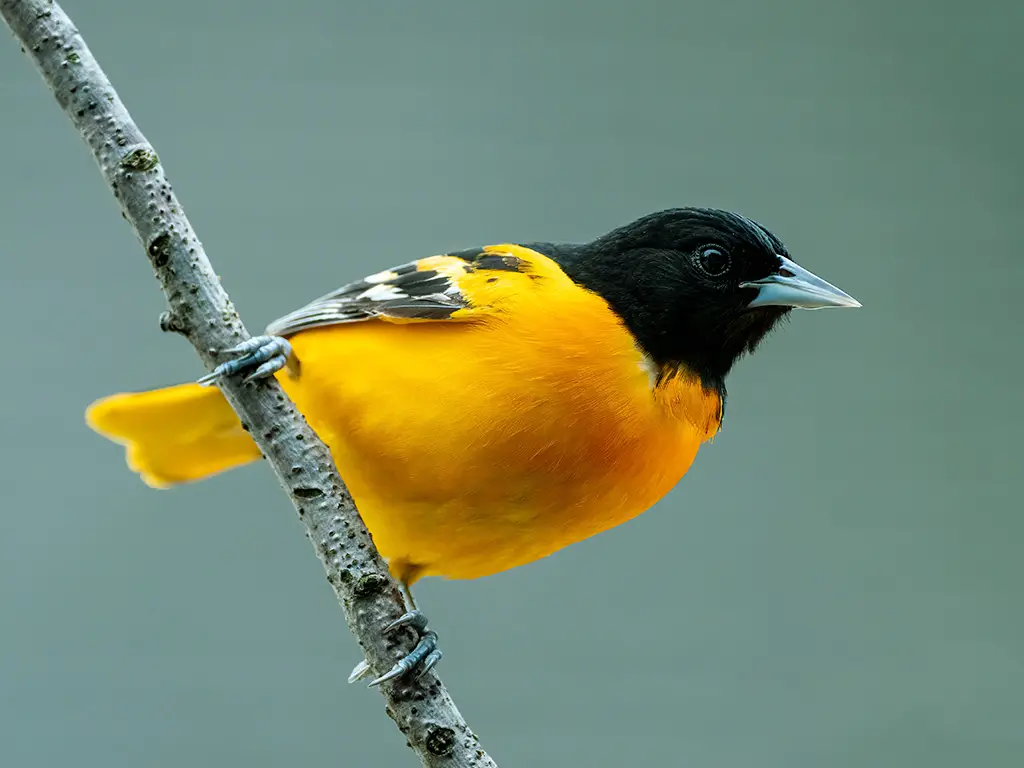
The Baltimore Oriole, scientifically known as Icterus galbula, is a strikingly vibrant and unmistakable bird native to North America. The male Baltimore Oriole is a sight to behold with its striking orange plumage and black wings.
These birds are known for their melodious and flute-like songs, which they use to communicate and attract mates during the breeding season.
They primarily inhabit deciduous forests, gardens, and orchards, where they forage for insects, fruit, and nectar.
Baltimore Orioles are migratory birds, spending their winters in Central America and returning to North America during the spring and summer months.
Their nests, intricately woven in the shape of a hanging pouch, are often found swaying from the branches of trees, making them a unique addition to the avian world.
| Kingdom | Animalia |
| Phylum | Chordata |
| Clade | Dinosauria |
| Class | Aves |
| Order | Passeriformes |
| Family | Icteridae |
| Genus | Icterus |
| Species | I. galbula |
2. American Robin (Turdus migratorius)
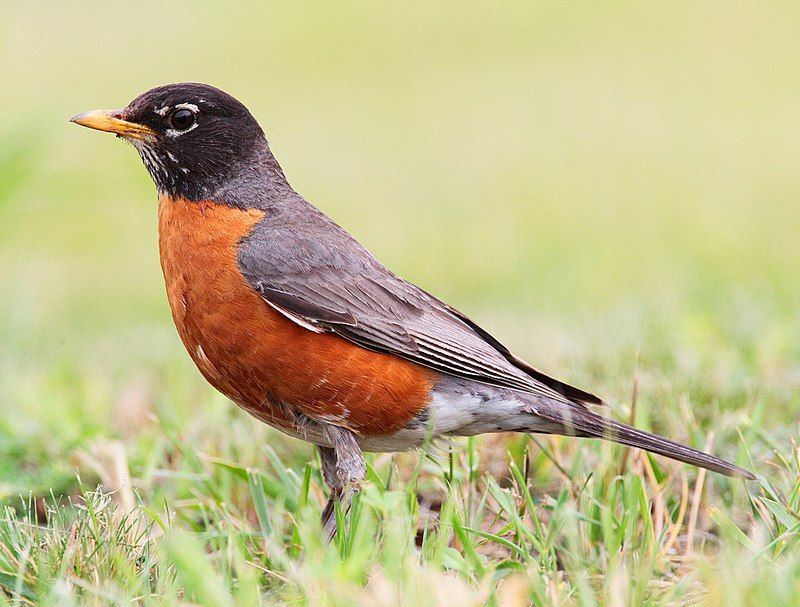
The American Robin, scientifically named Turdus migratorius, is a widely recognized and beloved bird across North America. Despite its name, it is not a true robin but rather a member of the thrush family.
These birds are known for their distinctive orange-red breasts, contrasting dark heads, and grayish-brown backs.
American Robins are commonly associated with the arrival of spring, as they are one of the first birds to return from their winter migration to the southern United States and Mexico. They are highly adaptable, thriving in various habitats, including urban areas, gardens, and woodlands.
American Robins primarily feed on earthworms, insects, and berries, and their cheerful songs are a staple sound of early mornings in the spring and summer.
These birds are essential in dispersing seeds and maintaining ecological balance in their habitats.
| Kingdom | Animalia |
| Phylum | Chordata |
| Clade | Dinosauria |
| Class | Aves |
| Order | Passeriformes |
| Family | Turdidae |
| Genus | Turdus |
| Species | T. migratorius |
3. Orchard Oriole (Icterus spurius)
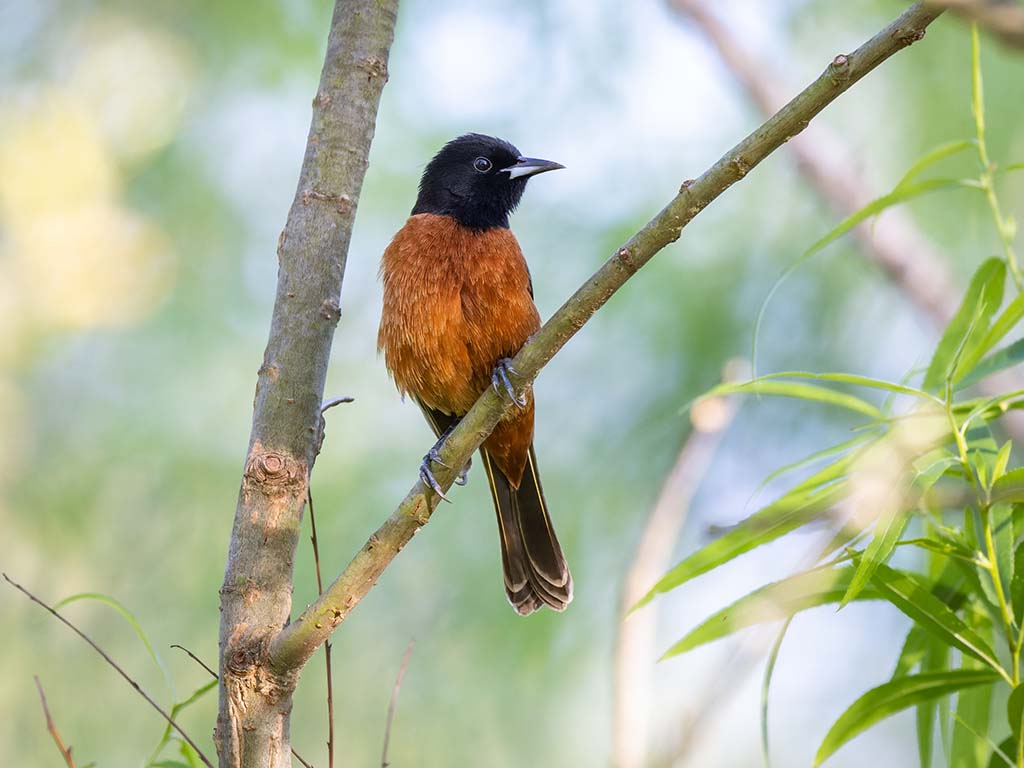
The Orchard Oriole, scientifically known as Icterus spurius, is a charming and small songbird native to North and Central America. The male Orchard Oriole boasts strikingly vibrant plumage, with its deep chestnut body and contrasting black wings and tail.
In contrast, the female has more subdued yellow-green hues. These orioles are often found in orchards, gardens, and open woodlands, feeding on insects, nectar, and fruit.
They are skilled in capturing insects in mid-air during their acrobatic flights. Their intricate hanging nests are usually hidden among dense foliage.
Orchard orioles are migratory birds that winter in Central America and breed in North America during the warmer months. Their melodious, flute-like songs add a delightful note to the avian chorus of summer.
| Kingdom | Animalia |
| Phylum | Chordata |
| Clade | Dinosauria |
| Class | Aves |
| Order | Passeriformes |
| Family | Icteridae |
| Genus | Icterus |
| Species | I. spurius |
4. Eastern Towhee (Pipilo erythrophthalmus)
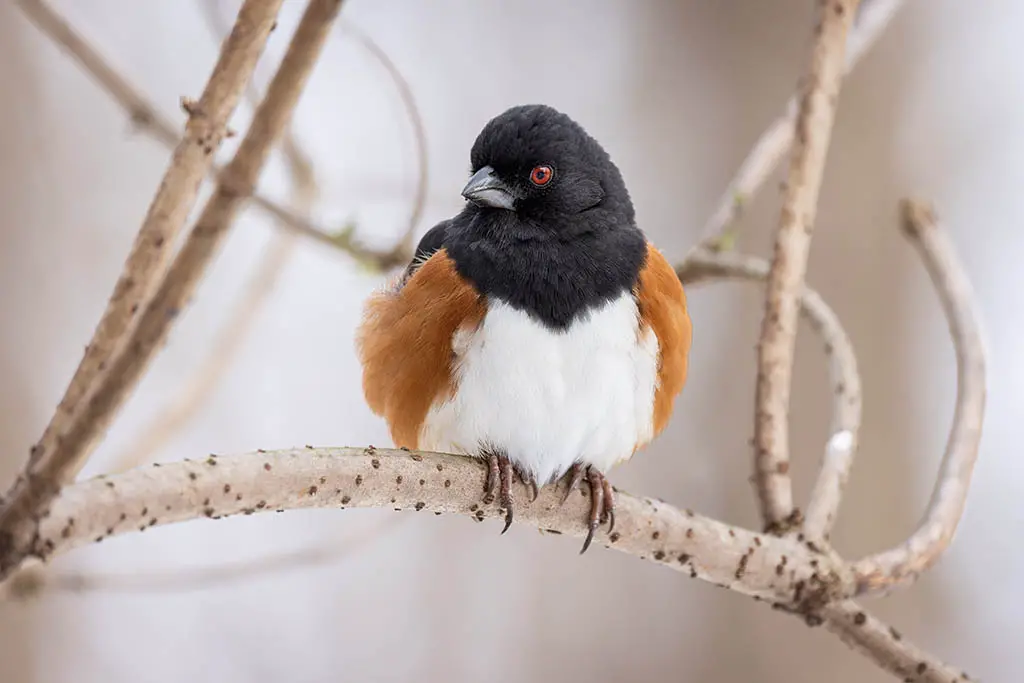
The Eastern Towhee, scientifically named Pipilo erythrophthalmus, is a distinctive bird found in eastern North America. Its striking black upperparts, rufous sides, and white belly make it easily recognizable.
Eastern Towhees inhabit various habitats, including dense shrubs, woodlands, and open areas with underbrush. They are ground-dwellers, often scratching through leaf litter for insects, seeds, and plant matter.
These birds are known for their unique “drink-your-tea” call, which sounds like they’re calling their own name. During the breeding season, males perform spirited and repetitive songs from elevated perches to establish territory and attract mates.
Eastern Towhees are known for their secretive behavior and are more often heard than seen, making them a challenge for birdwatchers to spot.
| Kingdom | Animalia |
| Phylum | Chordata |
| Clade | Dinosauria |
| Class | Aves |
| Order | Passeriformes |
| Family | Passerellidae |
| Genus | Pipilo |
| Species | P. erythrophthalmus |
5. American Redstart (Setophaga ruticilla):
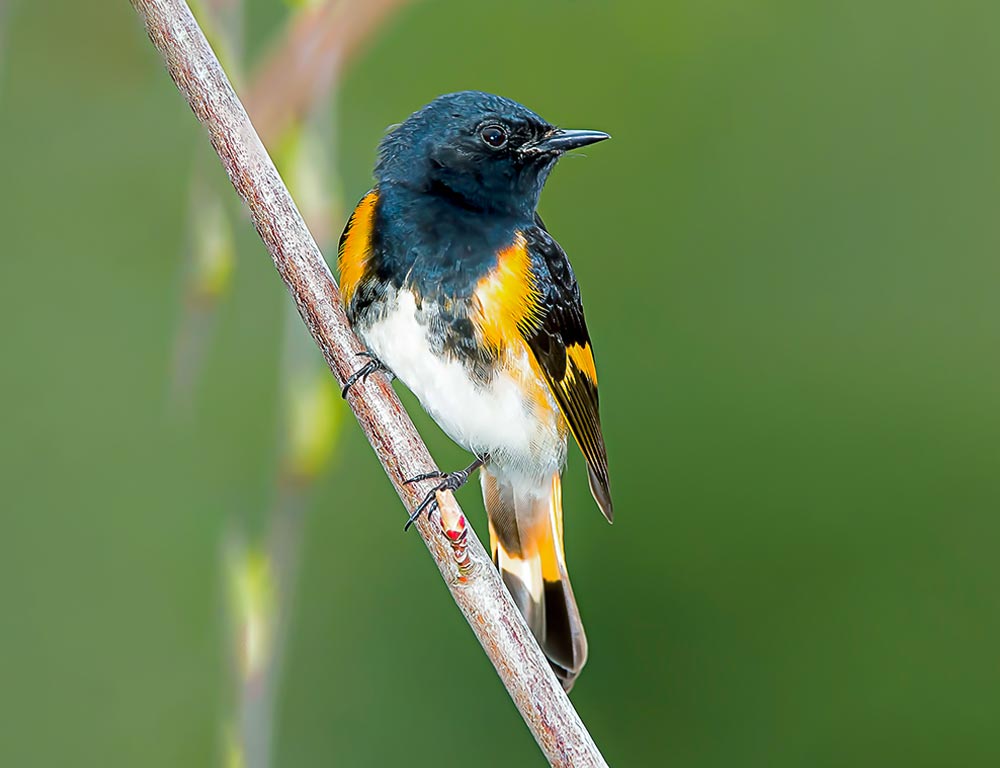
The American Redstart, known as Setophaga ruticilla, is a striking warbler species in North and Central America. Males are easily identifiable by their bold black plumage with vibrant orange patches on their wings, tails, and sides.
Females and immature birds are less flamboyant, with grayish-green plumage and yellow patches. American Redstarts prefer deciduous forests, woodlands, and riparian areas where they forage for insects, spiders, and small fruits.
These agile birds are known for their unique foraging behavior, rapidly flicking their wings and tails to flush out prey while displaying their striking orange patches.
Their high-pitched, insect-like songs add a delightful element to their presence in the forest canopy. These neotropical migrants spend their winters in Central and South America, making them a symbol of long-distance avian journeys.
| Kingdom | Animalia |
| Phylum | Chordata |
| Clade | Dinosauria |
| Class | Aves |
| Order | Passeriformes |
| Family | Parulidae |
| Genus | Setophaga |
| Species | S. ruticilla |
6. Blackburnian Warbler (Setophaga fusca)
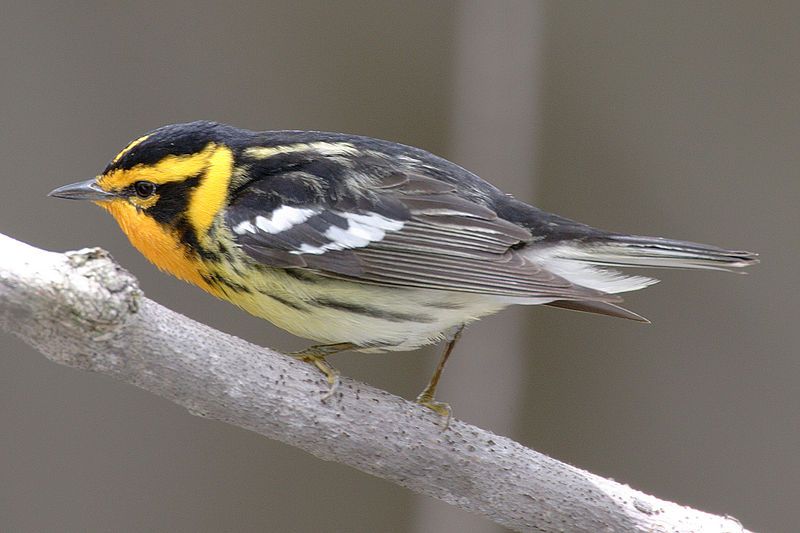
The Blackburnian Warbler, scientifically named Setophaga Fusca, is a stunning and eye-catching member of the Warbler family. Males are adorned with bright orange throats and crowns, contrasting beautifully with their black and white plumage.
This striking combination makes them easily distinguishable in their forest habitats. Blackburnian Warblers are typically found in coniferous and mixed woodlands across North America, where they actively forage for insects and spiders among the tree branches.
During the breeding season, their high-pitched songs resonate through the treetops, signaling their presence. Blackburnian Warblers can be challenging to spot despite their striking appearance due to their preference for high-canopy foliage.
They are neotropical migrants, wintering in Central and South America and returning to their breeding grounds in North America during the summer months.
| Kingdom | Animalia |
| Phylum | Chordata |
| Clade | Dinosauria |
| Class | Aves |
| Order | Passeriformes |
| Family | Parulidae |
| Genus | Setophaga |
| Species | S. fusca |
7. American Kestrel (Falco sparverius)
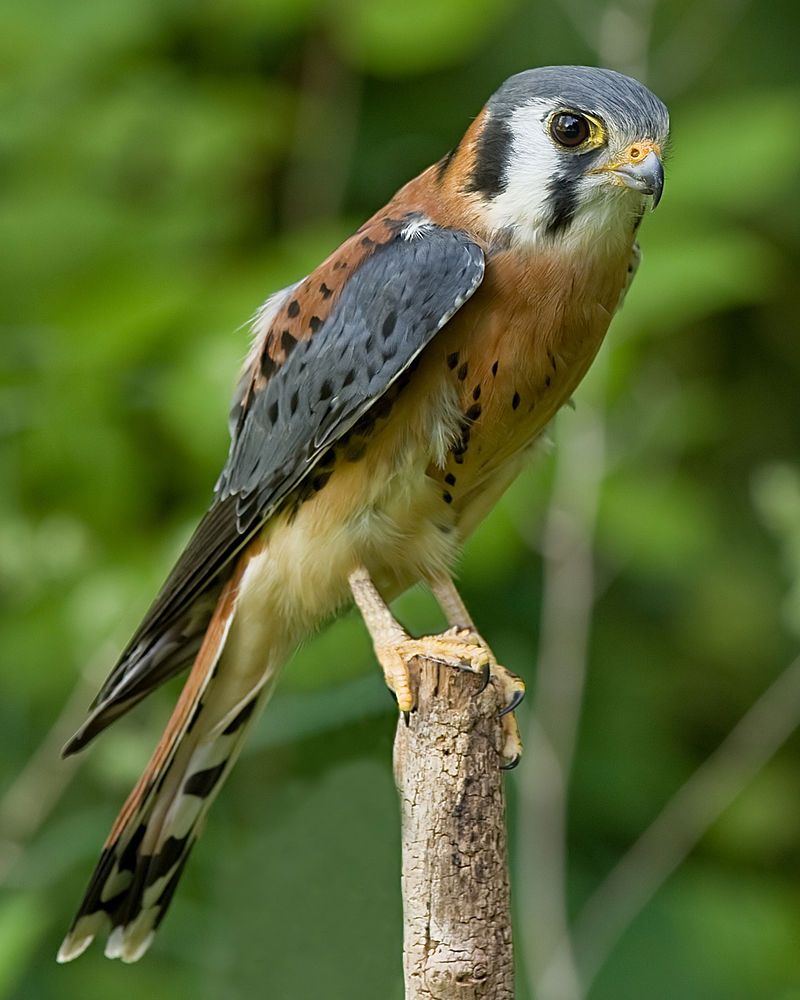
The American Kestrel, scientifically known as Falco sparverius, is North America’s smallest falcon and a captivating raptor species.
These birds are known for their colorful plumage, with males featuring distinctive blue-gray wings and heads, rusty-brown backs, and boldly patterned faces.
Females are slightly less colorful but still exhibit rusty plumage and streaked patterns. American Kestrels are versatile predators and can be found in various habitats, including grasslands, open fields, and urban areas.
They primarily feed on small mammals, insects, and birds, often hovering in place before diving to catch their prey. These raptors are known for their fierce hunting skills and agile flight.
Their calls consist of high-pitched klee-klee-klee sounds, which can be heard as they soar over their territories. American Kestrels are essential for controlling insect and rodent populations and are admired for their adaptability in diverse environments.
| Kingdom | Animalia |
| Phylum | Chordata |
| Clade | Dinosauria |
| Class | Aves |
| Order | Falconiformes |
| Family | Falconidae |
| Genus | Falco |
| Species | F. sparverius |
8. Rufous Hummingbird (Selasphorus rufus)
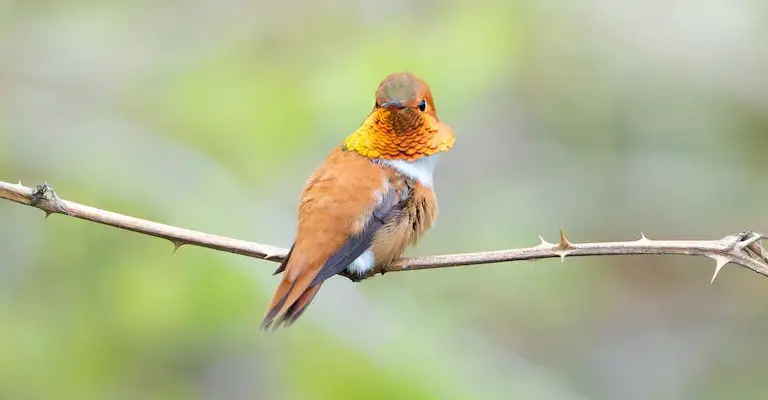
The Rufous Hummingbird, scientifically known as Selasphorus rufus, is a small and dazzling hummingbird species found in North America.
These tiny avian gems are known for their vibrant, fiery plumage, with males displaying brilliant orange-red throats and upperparts, while females have greenish-brown feathers.
Rufous Hummingbirds are migratory birds, traveling from their breeding grounds in western North America to their wintering grounds in Mexico and Central America.
They are highly agile fliers, capable of hovering in mid-air as they feed on nectar from flowers, supplemented by insects for protein.
Their energetic and territorial nature often leads to intense aerial displays and chases among males during the breeding season.
Observing these iridescent marvels is a true delight for birdwatchers, as their dazzling colors and aerial acrobatics are a testament to nature’s beauty.
| Kingdom | Animalia |
| Phylum | Chordata |
| Clade | Strisores |
| Class | Aves |
| Order | Apodiformes |
| Family | Trochilidae |
| Genus | Selasphorus |
| Species | S. rufus |
9. Black-Headed Grosbeak (Pheucticus melanocephalus)
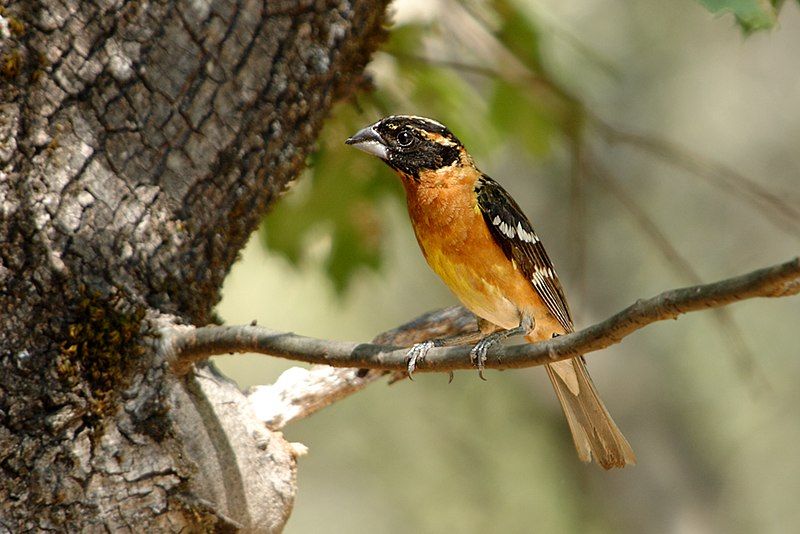
The Black-Headed Grosbeak, scientifically named Pheucticus melanocephalus, is a striking songbird found in western North America. Males are characterized by their jet-black heads, bright orange underparts, and bold white wing bars.
Their striking appearance and melodious songs make them a favorite among bird enthusiasts. These grosbeaks primarily inhabit woodlands, deciduous forests, and riparian areas where they forage for insects, seeds, and fruits.
During the breeding season, their rich, whistling songs echo through the treetops as they establish territories and attract mates.
Black-Headed Grosbeaks are migratory, spending their winters in Central America and Mexico before returning to North America for the breeding season.
Their strong beaks are adapted for cracking open seeds and nuts, making them important for seed dispersal in their ecosystems.
| Kingdom | Animalia |
| Phylum | Chordata |
| Clade | Dinosauria |
| Class | Aves |
| Order | Passeriformes |
| Family | Cardinalidae |
| Genus | Pheucticus |
| Species | P. melanocephalus |
10. Carolina Wren (Thryothorus ludovicianus)
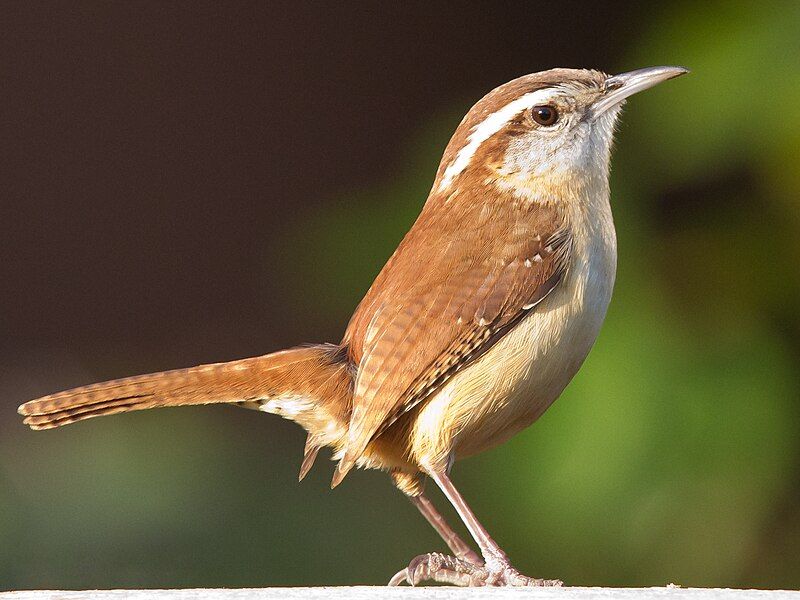
The Carolina Wren, scientifically known as Thryothorus ludovicianus, is a charming and vocal bird found in the southeastern United States.
These wrens are recognized for their warm reddish-brown plumage, bold white eyebrows, and distinctive, upward-curved tail.
Despite their small size, they have a robust and melodious song that resonates through the forests, gardens, and suburban areas they inhabit.
Carolina Wrens are adaptable birds, often seen foraging for insects, spiders, and seeds in dense vegetation, brush piles, and even nesting in human-made structures.
They are year-round residents in their range, whose cheerful songs can brighten even the dreariest days. These wrens are known for their strong pair bonds and are often seen in pairs or family groups.
| Kingdom | Animalia |
| Phylum | Chordata |
| Clade | Dinosauria |
| Class | Aves |
| Order | Passeriformes |
| Family | Troglodytidae |
| Genus | Thryothorus |
| Species | T. ludovicianus |
11. Varied Thrush (Ixoreus naevius)

The Varied Thrush, scientifically named Ixoreus naevius, is a captivating thrush species found in western North America.
Males and females both exhibit striking plumage, with a distinctive blue-gray back, bold black breast band, and rich orange markings on their underparts and eyebrows.
These thrushes inhabit coniferous and mixed forests, where they forage for insects, snails, and berries on the forest floor.
Varied Thrushes are known for their hauntingly beautiful, flute-like songs that echo through the dense woods, adding a sense of mystery to the forest ambiance.
They are often seen in urban and suburban areas during the winter months, making them a beloved and welcomed visitor to backyard bird feeders.
| Kingdom | Animalia |
| Phylum | Chordata |
| Clade | Dinosauria |
| Class | Aves |
| Order | Passeriformes |
| Family | Turdidae |
| Genus | Ixoreus |
| Species | I. naevius |
12. Bullock’s Oriole (Icterus bullockii)
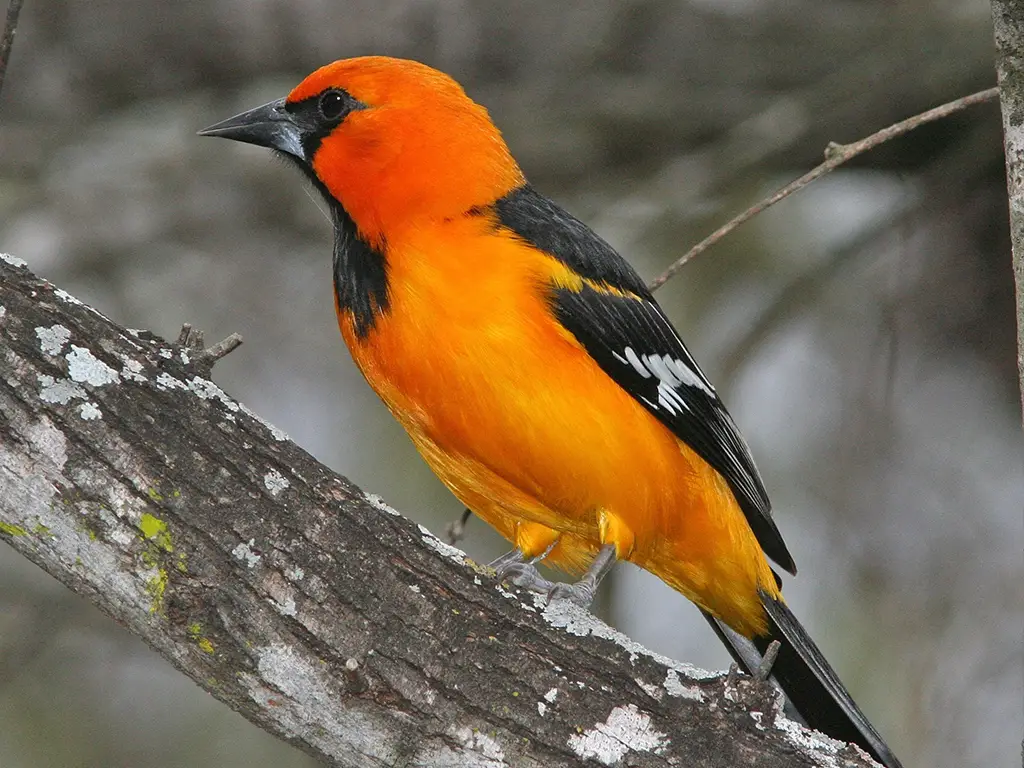
Bullock’s Oriole, scientifically known as Icterus bullockii, is a vibrant and captivating bird species native to western North America.
Males are adorned with striking orange-yellow plumage, black wings, and black eyeliner, while females exhibit more subdued yellow and grayish-brown tones.
These orioles primarily inhabit open woodlands, riparian areas, and oak savannas, where they forage for insects, spiders, and nectar from flowers.
Bullock’s Orioles are known for their intricate, pendulous nests that they weave from plant fibers and hang from the branches of trees.
Their songs are a delightful mix of melodious whistles and chattering, often heard during the breeding season as they establish territories and court mates.
These orioles are migratory, spending their winters in Mexico and Central America before returning to North America for the summer breeding season.
| Kingdom | Animalia |
| Phylum | Chordata |
| Clade | Dinosauria |
| Class | Aves |
| Order | Passeriformes |
| Family | Icteridae |
| Genus | Icterus |
| Species | I. bullockii |
Conclusion
Orange birds in Missouri are a unique and fascinating aspect of the state’s avian population. Although there is limited scientific evidence to support the existence of naturally occurring orange birds, there have been sightings and reports from reliable sources.
The potential explanations for their vibrant orange color could be attributed to genetic mutations, diet, or environmental factors. Regardless of the exact cause, orange birds bring a vibrant and captivating presence to Missouri’s diverse bird species.
Continued research and observation are necessary to understand and appreciate these orange birds’ presence in Missouri.